OMGOI COFFEE
OMGOI COFFEE
Knowledge of Coffee
Coffee is a perennial shrub in a medium size of about 3-4 meters high. The green leaves are broken in pairs. The flowers on the branches of the branch are pure white and fragrant.
Omkoi District, Chiang Mai Province, is considered a land suitable for growing Arabica coffee varieties. The land is approximately 800 - 1,200 meters above sea level. The soil is very fertile. The weather is cool all year round. The amount of rainfall is suitable for coffee growing. Indeed, the area is absolutely ready for growing Arabica coffee.
The coffee beans are round oval. The raw fruits are green. When ripe, the color will change to bright red like a cherry. This ripe fruit is therefore called "cherries" The seeds of most cherries look like nuts, which are split into two parts, only some of which have one seed which are very few. There are coffee varieties in this world. They are planted well around the equatorial regions of the world.
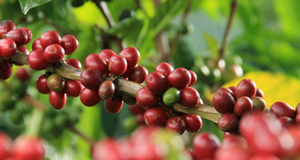
Coffee production process
The process of making coconut shell coffee:
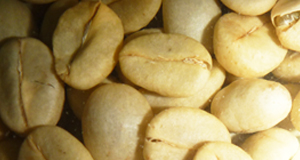
- Buy seeds from farmers by selecting the perfect seeds which must have the characteristics of red as cherry, without the green and dry black colors. Also, the broken seeds must be removed.
- Peel the shell with peeling machine within 24 hours using modern machinery.
- Coffee beans that are peeled outside will have mucus wrapped around the seeds which must be eliminated by means of fermentation or soaking the coffee beans in clean water for 2-3 nights to wash the mucus and then rinse with clean water for 1-2 more times.
- Take the coffee beans that have been washed to dry on a bamboo carriage covered with a plastic net that is about 70 centimeters above the floor. Spread the coffee beans evenly, not to be too thick, and the beans must be recovered every 3 hours. Take about 3-4 days to dry until the coffee beans have moisture content not more than 13%.
- Storage of coffee beans that have been dried must take the coffee beans to remove all impurities. Keep in the form of coconut shell coffee by packing in hemp sacks with good ventilation holes. The hemp sacks should be turned the inside out to air dry before use. Store in an open shed, ventilated, not damp or has a bad smell. The coffee beans can be stored for up to 2 years.
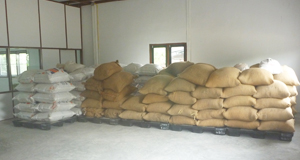
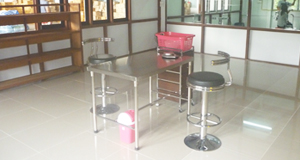
After completing the selection process and extracting the coffee beans and before having a cup of fragrant coffee, there was still a roasting process, which was the most important step.
Roasting process:
This refers to bringing raw coffee beans through heat or hot steam tubes inside the roasting tank at temperatures between 120-300 degrees Celsius. Before roasting, coffee beans must be selected by sorting machinery which is divided into 2 grades, A and Y.
Grade A has a diameter greater than 5.5 millimeters, and the one less than 5.5 millimeters is considered grade Y.
Roasting coffee beans takes about 10-20 minutes per set. Set the temperature down when coffee changes color. Check the seeds often. Compare with color swatch. When the coffee is roasted to the desired color, open the coffee beans from the roasting machine. Expel moisture and heat immediately by turning on the exhaust fan, and wait instantaneously.
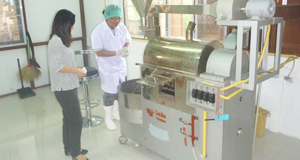
In general, coffee roasting is divided into 3 types.
- Light Roast is the lightest roast. Raw coffee beans from white or grayish green will change to medium brown, and there is no oil to adhere to the coffee beans. This type of roasting gives a high acidity and low intensity.
- Medium Roast is a raw coffee bean roasting from white or grayish green to a darker brown color of cinnamon. It is observable that coffee beans will have an oily skin like satin but still has no oil sticking.
- Dark Roast is a darker roast in that the color of raw coffee beans from white or grayish green will turn brown until dark brown. The coffee beans will have oil sticking from almost coffee beans to all over coffee beans. The temperature used is between 250-300 degrees Celsius.
How to preserve the quality of coffee
The roasted coffee beans should be kept in the aluminum bags because they can protect sunlight and moisture very well. The sunlight and humidity in the air are the cause of the coffee to change the flavor. Therefore, the air inside the bags should be expelled as much as possible. Close the bags tightly using bag clips.

